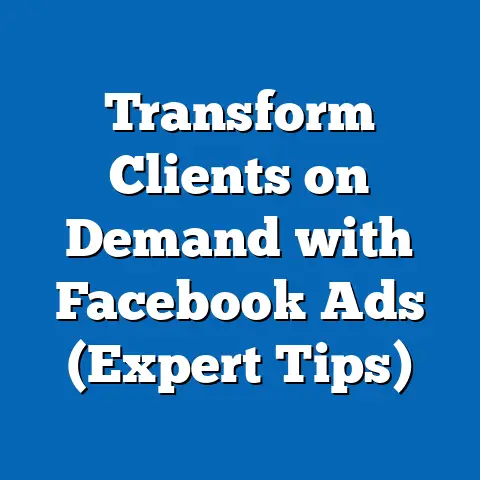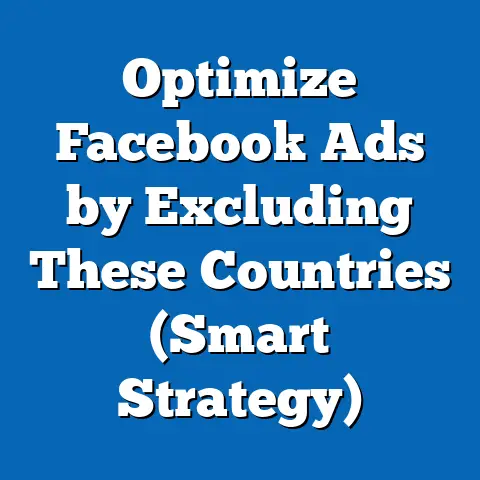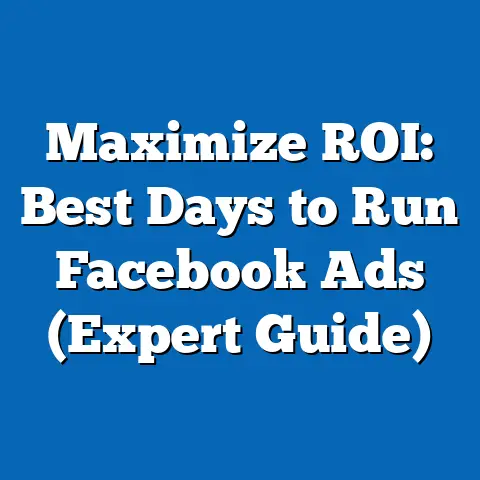Maximize Real Estate Sales with Facebook Ads (Pro Strategies)
It’s a common misconception I hear all the time: “Facebook Ads? Those are for boutiques and burger joints, not for selling million-dollar homes!” Or, “Real estate is all about shaking hands and attending local events. Facebook is just a distraction.” I get it. For years, real estate marketing has relied on traditional methods: glossy brochures, open houses buzzing with activity, print ads in local newspapers, and the lifeblood of the industry – personal referrals.
But I’m here to tell you that dismissing Facebook Ads in the real estate world is like ignoring a goldmine. You’re leaving potential clients on the table and missing out on a powerful platform that can deliver hyper-targeted advertising, massive reach, and – most importantly – measurable results.
I’ve seen firsthand how Facebook Ads can transform a real estate agent’s business. From generating qualified leads to building brand awareness and showcasing stunning properties, the possibilities are vast. This isn’t just about posting pretty pictures; it’s about crafting a strategic campaign that speaks directly to your ideal client.
Section 1: Understanding the Power of Facebook Ads in Real Estate
Before we jump into the “how,” let’s explore the “why.” Why should you, a real estate professional, be investing your time and money into Facebook Ads? The answer lies in the sheer scale and power of the platform.
The Untapped Potential: Facebook’s Audience and Engagement
Let’s start with some numbers. Facebook boasts billions of active users worldwide. But don’t get overwhelmed by the sheer size. What’s truly remarkable is the level of detail Facebook collects about its users. This data allows us to pinpoint the exact individuals who are most likely to be interested in buying or selling a home.
Think about it:
- Demographics: Facebook knows age, location, income level, education, family status, and even job titles. Imagine targeting ads specifically to young professionals in your city who are likely first-time homebuyers.
- Interests: Are people liking pages about home decor, renovation projects, or real estate investing? Facebook tracks these interests, allowing you to reach individuals who are actively thinking about their living situation.
- Behaviors: Facebook tracks online behavior, including recent life events like getting married, having a baby, or moving to a new city. These are all potential triggers for a real estate transaction.
This level of granular targeting is simply unmatched by traditional marketing methods. You’re not just throwing a message into the void; you’re delivering it directly to the people who are most receptive to it.
Facebook Ads vs. Traditional Marketing: A Clear Winner?
Okay, so Facebook has a lot of users. But how does it stack up against the traditional real estate marketing tactics you’re already familiar with? Let’s break it down:
| Feature | Facebook Ads | Traditional Marketing (Print, Open Houses, etc.) |
|---|---|---|
| Targeting | Hyper-targeted based on demographics, interests, behaviors, and custom audiences. | Broad targeting, often limited to geographical area. |
| Reach | Potentially massive reach, both locally and globally. | Limited reach, primarily within a specific geographical area. |
| Cost | Flexible budget, allowing you to control your spending and optimize for ROI. | Often expensive, with limited control over costs. |
| Measurability | Detailed analytics and reporting, allowing you to track key metrics and measure the effectiveness of your campaigns. | Difficult to measure effectiveness, relying on anecdotal evidence and limited data. |
| Engagement | Interactive ads that encourage engagement (likes, comments, shares, clicks). | Passive ads that offer limited opportunities for engagement. |
| Flexibility | Easy to adjust and optimize campaigns in real-time based on performance data. | Difficult to change or adjust campaigns once they are launched. |
| Speed | Campaigns can be launched and generating leads within hours. | Campaigns can take weeks or months to plan and execute. |
| Feature | Facebook Ads | Traditional Marketing (Print, Open Houses, etc.) |
|---|---|---|
| Targeting | Hyper-targeted based on demographics, interests, behaviors, and custom audiences. | Broad targeting, often limited to geographical area. |
| Reach | Potentially massive reach, both locally and globally. | Limited reach, primarily within a specific geographical area. |
| Cost | Flexible budget, allowing you to control your spending and optimize for ROI. | Often expensive, with limited control over costs. |
| Measurability | Detailed analytics and reporting, allowing you to track key metrics and measure the effectiveness of your campaigns. | Difficult to measure effectiveness, relying on anecdotal evidence and limited data. |
| Engagement | Interactive ads that encourage engagement (likes, comments, shares, clicks). | Passive ads that offer limited opportunities for engagement. |
| Flexibility | Easy to adjust and optimize campaigns in real-time based on performance data. | Difficult to change or adjust campaigns once they are launched. |
| Speed | Campaigns can be launched and generating leads within hours. | Campaigns can take weeks or months to plan and execute. |
While traditional methods still have their place (especially for building local relationships), Facebook Ads offer a level of precision, measurability, and cost-effectiveness that simply can’t be ignored.
Real Estate Success Stories: Facebook Ads in Action
Let’s move beyond theory and look at some real-world examples of how Facebook Ads are driving results for real estate professionals:
- Increased Lead Generation: A real estate agent in San Diego used Facebook Ads to target first-time homebuyers in a specific zip code. By showcasing beautiful property photos and highlighting affordable financing options, they generated a flood of qualified leads and closed several deals within a few months.
- Enhanced Brand Awareness: A real estate agency in Austin created a series of video ads showcasing their expertise in the local market. These ads not only generated leads but also significantly increased brand awareness and established the agency as a trusted resource for buyers and sellers.
- Faster Property Sales: A real estate developer in Miami used Facebook Ads to promote a new luxury condo development. By targeting affluent individuals with interests in real estate investing and luxury travel, they generated significant interest in the project and sold out several units before the official launch date.
These are just a few examples of the power of Facebook Ads in real estate. By understanding the platform’s capabilities and crafting a strategic approach, you can achieve similar results and take your business to the next level.
Key Takeaway: Facebook Ads offer unparalleled targeting, reach, and measurability compared to traditional real estate marketing methods. By leveraging the platform’s capabilities, you can generate more leads, build brand awareness, and sell properties faster.
Next Step: Start exploring Facebook Ads Manager and familiarize yourself with the platform’s features and targeting options.
Section 2: Crafting the Perfect Facebook Ad
Now that we’ve established the power of Facebook Ads, let’s dive into the nuts and bolts of creating a high-performing ad. It’s not enough to simply throw up a picture of a house and hope for the best. You need to craft an ad that grabs attention, sparks interest, and compels people to take action.
The Anatomy of a Winning Real Estate Ad
A successful Facebook ad for real estate consists of several key components:
- Eye-Catching Visuals: In the fast-paced world of social media, visuals are king. Your ad needs to stand out from the crowd and grab attention instantly.
- Compelling Copy: Once you’ve captured someone’s attention, you need to hold it with persuasive ad copy that highlights the property’s key features and benefits.
- Clear Call-to-Action (CTA): Tell people exactly what you want them to do. Whether it’s visiting your website, scheduling a showing, or downloading a brochure, make it clear and easy for them to take the next step.
Let’s break down each of these components in more detail.
1. Eye-Catching Visuals: Show, Don’t Just Tell
In the world of real estate, visuals are everything. High-quality images and videos are essential for showcasing your properties in the best possible light.
- Professional Photography: Invest in professional photography to capture stunning images of your properties. Pay attention to lighting, composition, and staging to create a visually appealing presentation.
- Video Tours: Video tours are a great way to give potential buyers a virtual walkthrough of a property. Highlight key features and benefits and create a sense of excitement and anticipation.
- Lifestyle Imagery: Don’t just focus on the property itself. Include images that showcase the surrounding neighborhood, local amenities, and the overall lifestyle that the property offers.
- Ad Format Matters:
- Single Image Ads: Perfect for showcasing a property’s best feature.
- Carousel Ads: Allow you to display multiple images or videos, highlighting different aspects of a property or neighborhood.
- Video Ads: Ideal for creating immersive experiences and showcasing property tours.
- Collection Ads: Showcase a catalog of properties, allowing users to browse and explore different options.
- Single Image Ads: Perfect for showcasing a property’s best feature.
- Carousel Ads: Allow you to display multiple images or videos, highlighting different aspects of a property or neighborhood.
- Video Ads: Ideal for creating immersive experiences and showcasing property tours.
- Collection Ads: Showcase a catalog of properties, allowing users to browse and explore different options.
2. Compelling Copy: Write to Connect
Your ad copy is your opportunity to tell a story and connect with potential buyers on an emotional level.
- Strong Verbs: Use strong verbs that encourage action, such as “Learn More,” “Schedule a Showing,” “Download Our Brochure,” or “Contact Us.”
- Sense of Urgency: Create a sense of urgency by using phrases like “Limited Time Offer” or “Don’t Miss Out.”
- Relevance: Make sure your CTA is relevant to the ad content and the target audience.
- Placement: Place your CTA prominently in the ad, making it easy for people to see and click.
- Facebook’s Built-In CTAs: Facebook offers a variety of built-in CTA buttons that you can use in your ads, such as “Learn More,” “Shop Now,” “Sign Up,” and “Contact Us.”
A/B Testing: The Key to Optimization
Creating the perfect Facebook ad is an iterative process. You need to test different elements and see what resonates best with your target audience.
- Test Different Headlines: Try different headlines to see which ones generate the most clicks.
- Experiment with Visuals: Test different images and videos to see which ones grab the most attention.
- Vary Your CTAs: Try different CTAs to see which ones generate the most conversions.
- Facebook’s A/B Testing Tool: Facebook offers a built-in A/B testing tool that makes it easy to test different ad variations and track their performance.
By continuously testing and optimizing your ads, you can improve your results over time and maximize your ROI.
Key Takeaway: A winning Facebook ad for real estate consists of eye-catching visuals, compelling copy, and a clear call-to-action. A/B testing is essential for optimizing your ads and improving their performance.
Next Step: Start experimenting with different ad formats, headlines, visuals, and CTAs to see what resonates best with your target audience.
Section 3: Targeting Your Audience Effectively
You can have the most beautiful ad in the world, but if you’re showing it to the wrong people, it’s not going to generate any results. That’s why targeting is so crucial in Facebook advertising.
Facebook offers a wide range of targeting options that allow you to reach specific demographics, interests, and behaviors. By leveraging these features, you can ensure that your ads are seen by the people who are most likely to be interested in buying or selling a home.
Facebook’s Targeting Powerhouse: A Deep Dive
Let’s explore some of the key targeting options available in Facebook Ads Manager:
- Demographic Targeting: This allows you to target people based on their age, gender, location, education, income level, family status, and job title.
- Interest Targeting: This allows you to target people based on their interests, hobbies, and the pages they like on Facebook.
- Behavioral Targeting: This allows you to target people based on their online behavior, such as recent life events, purchase history, and device usage.
- Custom Audiences: This allows you to target people based on your own customer data, such as email lists, phone numbers, and website visitors.
- Lookalike Audiences: This allows you to target people who are similar to your existing customers, based on their demographics, interests, and behaviors.
Let’s break down each of these options in more detail.
1. Demographic Targeting: The Foundation
Demographic targeting is the foundation of Facebook advertising. It allows you to narrow your audience based on basic characteristics like age, gender, location, and income.
- Location: Target people who live in a specific city, state, or zip code. You can also target people who have recently visited a specific location.
- Age: Target people within a specific age range, such as 25-34 for first-time homebuyers or 55+ for retirees.
- Gender: Target men or women, or both.
- Education: Target people based on their education level, such as college graduates or those with advanced degrees.
- Income: Target people based on their estimated income level.
- Family Status: Target people based on their family status, such as married, single, or parents.
- Job Title: Target people based on their job title, such as real estate investors or executives.
2. Interest Targeting: The Art of Relevance
Interest targeting allows you to reach people who have expressed an interest in specific topics or hobbies. This is a powerful way to connect with potential buyers who are already thinking about real estate.
- Home Decor: Target people who like pages about home decor, interior design, and renovation projects.
- Real Estate Investing: Target people who like pages about real estate investing, property management, and mortgage rates.
- Luxury Living: Target people who like pages about luxury travel, high-end cars, and designer brands.
- Specific Neighborhoods: Target people who like pages about specific neighborhoods or communities in your area.
- Competitors: Target people who like pages of your competitors.
3. Behavioral Targeting: Understanding Actions
Behavioral targeting allows you to reach people based on their online behavior, such as recent life events or purchase history.
- Recent Life Events: Target people who have recently gotten married, had a baby, or moved to a new city.
- Purchase History: Target people who have recently purchased real estate or mortgage products.
- Device Usage: Target people based on the type of device they use, such as smartphones or tablets.
- Travel Habits: Target people who travel frequently or have recently visited a specific location.
4. Custom Audiences: Your Secret Weapon
Custom Audiences allow you to target people based on your own customer data. This is a powerful way to reach your existing clients and generate repeat business.
- Email Lists: Upload your email list to Facebook and target those contacts with your ads.
- Phone Numbers: Upload your phone number list to Facebook and target those contacts with your ads.
- Website Visitors: Install the Facebook Pixel on your website and track visitors. You can then target those visitors with your ads.
- App Users: Target people who have downloaded your mobile app.
5. Lookalike Audiences: Expanding Your Reach
Lookalike Audiences allow you to target people who are similar to your existing customers. This is a great way to expand your reach and find new potential buyers.
- Base Audience: Choose a Custom Audience as your base audience.
- Facebook’s Algorithm: Facebook will analyze the demographics, interests, and behaviors of your base audience and find people who are similar to them.
- Reach New Prospects: This is a powerful way to reach people who are likely to be interested in your properties but are not yet aware of your business.
Building Effective Audience Segments: Examples
Here are some examples of how to create effective audience segments based on different property types and buyer personas:
- Luxury Homes:
- Demographics: Age 35-65, Income $200,000+, Location: Affluent neighborhoods.
- Interests: Luxury travel, fine dining, designer brands, real estate investing.
- Behaviors: Frequent international travel, recent purchase of luxury goods.
- Starter Homes:
- Demographics: Age 25-34, Income $50,000-$100,000, Location: Up-and-coming neighborhoods.
- Interests: Home decor, DIY projects, first-time homebuyer resources.
- Behaviors: Recent marriage, recent birth of a child.
- Investment Properties:
- Demographics: Age 35-55, Income $150,000+, Location: Major metropolitan areas.
- Interests: Real estate investing, property management, financial planning.
- Behaviors: Active stock market investor, frequent online research about real estate.
- Demographics: Age 35-65, Income $200,000+, Location: Affluent neighborhoods.
- Interests: Luxury travel, fine dining, designer brands, real estate investing.
- Behaviors: Frequent international travel, recent purchase of luxury goods.
- Demographics: Age 25-34, Income $50,000-$100,000, Location: Up-and-coming neighborhoods.
- Interests: Home decor, DIY projects, first-time homebuyer resources.
- Behaviors: Recent marriage, recent birth of a child.
- Demographics: Age 35-55, Income $150,000+, Location: Major metropolitan areas.
- Interests: Real estate investing, property management, financial planning.
- Behaviors: Active stock market investor, frequent online research about real estate.
Key Takeaway: Effective targeting is essential for maximizing the ROI of your Facebook Ads. By leveraging Facebook’s targeting options, you can reach the right audience with the right message at the right time.
Next Step: Start experimenting with different targeting options and audience segments to see what generates the best results for your business.
Section 4: Budgeting and Bidding Strategies
Now that you know how to create compelling ads and target the right audience, let’s talk about money. How much should you spend on Facebook Ads, and how can you optimize your ad spend for maximum ROI?
Understanding Facebook Ad Budgets
Facebook offers two main budgeting options:
- Daily Budget: This allows you to set a fixed amount that you’re willing to spend each day.
- Lifetime Budget: This allows you to set a total amount that you’re willing to spend over the entire duration of your campaign.
Which option is right for you? It depends on your goals and your level of experience.
- Daily Budget: This is a good option if you want to run your ads continuously and have more control over your daily spending.
- Lifetime Budget: This is a good option if you want to run your ads for a specific period of time, such as a week or a month.
Setting an Appropriate Budget: Finding the Sweet Spot
How much should you spend on Facebook Ads for your real estate business? There’s no one-size-fits-all answer, but here are some factors to consider:
- Your Goals: What are you trying to achieve with your Facebook Ads? Are you trying to generate leads, build brand awareness, or sell properties faster?
- Your Target Audience: How large is your target audience? The larger your audience, the more you’ll need to spend to reach them.
- Your Competition: How much are your competitors spending on Facebook Ads? You may need to spend more to compete effectively.
- Your Budget: How much can you afford to spend on Facebook Ads? Be realistic and set a budget that you can comfortably afford.
As a general rule of thumb, I recommend starting with a daily budget of \$10-\$20 per ad set. This will allow you to test different ads and targeting options without breaking the bank. Once you’ve identified what’s working, you can gradually increase your budget to scale your results.
Bidding Strategies: Optimizing for ROI
Facebook offers several different bidding strategies that you can use to optimize your ad spend for maximum ROI.
- Lowest Cost: This is the default bidding strategy. Facebook will try to get you the most results for your budget, without regard to cost per result.
- Cost Cap: This allows you to set a maximum cost per result. Facebook will try to get you results at or below your target cost.
- Target Cost: This allows you to set a target cost per result. Facebook will try to get you results as close to your target cost as possible.
- Bid Cap: This allows you to set a maximum bid for each auction. Facebook will bid up to your maximum bid to win the auction.
Which bidding strategy is right for you? It depends on your goals and your level of experience.
- Lowest Cost: This is a good option if you’re new to Facebook Ads and want to get the most results for your budget.
- Cost Cap: This is a good option if you have a specific cost per result in mind and want to control your spending.
- Target Cost: This is a good option if you have a specific target cost per result in mind and want to get results as close to that cost as possible.
- Bid Cap: This is a good option if you’re an experienced advertiser and want to have more control over the bidding process.
Analyzing Ad Performance Metrics: The Key to Optimization
The key to optimizing your ad spend is to continuously monitor and analyze your ad performance metrics.
Here are some of the key metrics to track:
- Impressions: The number of times your ad was shown.
- Reach: The number of unique people who saw your ad.
- Clicks: The number of times people clicked on your ad.
- Click-Through Rate (CTR): The percentage of people who saw your ad and clicked on it.
- Cost Per Click (CPC): The average cost you paid for each click on your ad.
- Conversions: The number of people who took a desired action after clicking on your ad, such as submitting a lead form or scheduling a showing.
- Cost Per Acquisition (CPA): The average cost you paid for each conversion.
- Return on Ad Spend (ROAS): The amount of revenue you generated for every dollar you spent on ads.
By tracking these metrics, you can identify which ads and targeting options are performing well and which ones are not. You can then adjust your budget and bidding strategies accordingly to improve your results.
Key Takeaway: Setting an appropriate budget and optimizing your bidding strategies are essential for maximizing the ROI of your Facebook Ads. By continuously monitoring and analyzing your ad performance metrics, you can identify what’s working and what’s not, and make adjustments accordingly.
Next Step: Start experimenting with different budgeting options and bidding strategies to see what generates the best results for your business.
Section 5: Measuring Success and Making Adjustments
You’ve launched your Facebook Ads campaign, but the work doesn’t stop there. It’s crucial to track your results, analyze your data, and make adjustments to optimize your performance over time. This is where the true power of Facebook Ads lies – the ability to continuously improve and refine your strategies based on real-time data.
Key Performance Indicators (KPIs) for Real Estate Facebook Ads
To effectively measure the success of your Facebook Ads campaigns, you need to track the right Key Performance Indicators (KPIs). Here are some of the most important KPIs for real estate professionals:
- Lead Generation: The number of leads generated by your ads. This is a crucial KPI for measuring the effectiveness of your lead generation campaigns.
- Cost Per Lead (CPL): The average cost you paid for each lead generated by your ads. This is a key metric for optimizing your ad spend.
- Website Traffic: The amount of traffic your ads are driving to your website. This is a good indicator of brand awareness and engagement.
- Engagement Rate: The percentage of people who are interacting with your ads, such as liking, commenting, and sharing. This is a good indicator of the relevance and appeal of your ads.
- Conversion Rate: The percentage of people who are taking a desired action after clicking on your ad, such as submitting a lead form or scheduling a showing. This is a key metric for measuring the effectiveness of your ads in driving business results.
- Return on Ad Spend (ROAS): The amount of revenue you generated for every dollar you spent on ads. This is the ultimate metric for measuring the profitability of your Facebook Ads campaigns.
Monitoring and Analyzing Ad Performance in Facebook Ads Manager
Facebook Ads Manager provides a wealth of data and reporting tools that you can use to track your ad performance. Make sure to regularly monitor your ad performance and analyze your data to identify trends and opportunities for improvement.
Here are some tips for monitoring and analyzing your ad performance:
- Customize Your Columns: Customize the columns in Facebook Ads Manager to display the KPIs that are most important to you.
- Use Filters: Use filters to segment your data and analyze the performance of specific ads, ad sets, and campaigns.
- Create Reports: Create custom reports to track your ad performance over time.
- Export Your Data: Export your data to a spreadsheet or other analysis tool for more in-depth analysis.
Data-Driven Decisions: Refining Your Strategies
The data you collect from Facebook Ads Manager can be used to make informed decisions about how to refine your ad strategies.
Here are some examples of how to use data to improve your ad performance:
- Identify Underperforming Ads: If an ad is not generating leads or conversions, try changing the headline, the image, or the targeting options.
- Optimize Your Targeting: If you’re not reaching the right audience, try refining your targeting options based on the demographics, interests, and behaviors of your most successful customers.
- Adjust Your Budget: If an ad set is performing well, consider increasing your budget to scale your results. If an ad set is not performing well, consider decreasing your budget or pausing the ad set altogether.
- Test Different Ad Formats: Experiment with different ad formats, such as carousel ads, video ads, and lead ads, to see which ones generate the best results for your business.
Leveraging Feedback from Leads and Clients
In addition to analyzing your data in Facebook Ads Manager, it’s also important to gather feedback from your leads and clients. Ask them how they found you, what they liked about your ads, and what you could do to improve.
This feedback can provide valuable insights into the effectiveness of your ads and help you to create more compelling and relevant messaging.
A Continuous Cycle of Improvement
Measuring success and making adjustments is not a one-time event. It’s a continuous cycle of improvement. By regularly monitoring your ad performance, analyzing your data, and gathering feedback from your leads and clients, you can continuously refine your ad strategies and maximize your ROI.
Key Takeaway: Measuring success and making adjustments is essential for optimizing your Facebook Ads campaigns. By tracking the right KPIs, monitoring your ad performance, and leveraging feedback from your leads and clients, you can continuously improve your results and maximize your ROI.
Next Step: Set up a system for tracking your ad performance and analyzing your data. Schedule regular reviews of your data to identify trends and opportunities for improvement.
Conclusion
We’ve covered a lot of ground in this guide, from understanding the power of Facebook Ads in real estate to crafting the perfect ad, targeting the right audience, budgeting wisely, and measuring your success.
Hopefully, I’ve shattered that initial misconception that Facebook Ads are only for retail businesses. I’ve shown you that Facebook Ads can be a game-changer for real estate agents and agencies, providing a platform that allows for hyper-targeted advertising, extensive reach, and measurable results.
I encourage you to adopt a proactive approach and implement the strategies I’ve outlined in this article. Don’t be afraid to experiment, test new ideas, and continuously refine your strategies based on data and feedback.
Remember, the potential of Facebook Ads to transform your real estate marketing efforts is immense. Embrace the power of this platform, stay curious, and never stop innovating. Your next big sale could be just one click away.






